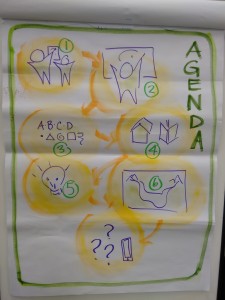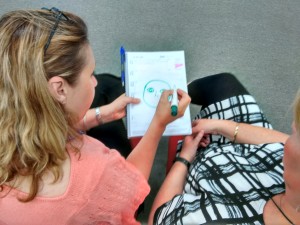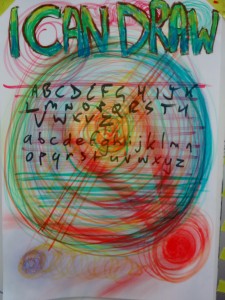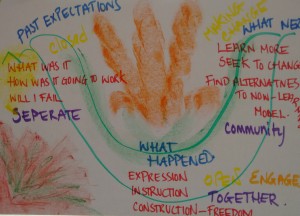This is the fourth in a series of posts about my ISS/Chisholm Fellowship in Victoria State, Australia. You can find the previous posts here: Part 1, Part 2 and Part 3. While I intended to write these WHILE in Australia, it has, er, ahem, taken a bit longer.
When Brad Beach (of Chisholm) and I were noodling on what I might share through my fellowship, I was exceedingly happy that he was willing to step out of the more traditional practices and dive into visual or graphic facilitation. We scheduled two rounds of a 3 hour “Doodle, Draw, Learn” workshops to introduce teachers to the power of visuals for engagement and learning. I think we accomplished this well in the workshops. They also reminded me of something else that happens when we allow ourselves to freely draw. Joy fills the room.
 As before, I’ll share the content points first as reference, then reflect on my experience and share a few words from the participants. Finally, there is a visual artifact at the end with resources, support materials and a deck compiling all the images from the day.
As before, I’ll share the content points first as reference, then reflect on my experience and share a few words from the participants. Finally, there is a visual artifact at the end with resources, support materials and a deck compiling all the images from the day.
The structure of the workshop is designed around modeling an interactive initial engagement visual activity, unleashing of drawing joy (“I CAN DRAW”), development of icon skills and wrapped up with another visual activity, this time focused on reflection and evaluation. The agenda is communicated using a visual agenda (of course, and from the photo, you can see this works even on wrinkled flip chart paper) and the feedback is captured with video – another visual medium. In the middle I share example visual artifacts and offer a few thoughts so people can get off their feet and rest for a few minutes. This is where we begin the conversation about where to apply visual practices in the classroom – online or offline.
All in all, this is a very ACTIVE experience. But people generally report being energized, rather than exhausted. Interesting, eh?
Process
Here are brief descriptions of the exercises, in case you want to try them:
 Paired Drawing: I learned this from Johnnie Moore www.johnniemoore.com/blog/archives/000380.php and have blogged about it. One pen, one paper, two people taking turns drawing a face, one pen stroke at a time with NO TALKING. There are so many ways to relate this activity to your teaching or meeting goals. It is great not only to “break the ice” but to show patterns of communication and collaboration and the interesting effect of assumptions! More photos here.
Paired Drawing: I learned this from Johnnie Moore www.johnniemoore.com/blog/archives/000380.php and have blogged about it. One pen, one paper, two people taking turns drawing a face, one pen stroke at a time with NO TALKING. There are so many ways to relate this activity to your teaching or meeting goals. It is great not only to “break the ice” but to show patterns of communication and collaboration and the interesting effect of assumptions! More photos here. I CAN DRAW: This is again a common and fabulous activity that is used in MANY introductory graphic facilitation workshops. I learned mine from the folks at the International Forum of Visual Practitioners (IFVP) and have seen it done many times with amazing variation. The essence is getting up at a wall and using our bodies to draw circles and lines, play with color using chalk pastels and finally getting a sense of the basics of lettering, including size and proportion.Pastels are messy, but they are MAGIC. Something always happens in the room when we use the pastels. I think this is where the joy really becomes visible.
I CAN DRAW: This is again a common and fabulous activity that is used in MANY introductory graphic facilitation workshops. I learned mine from the folks at the International Forum of Visual Practitioners (IFVP) and have seen it done many times with amazing variation. The essence is getting up at a wall and using our bodies to draw circles and lines, play with color using chalk pastels and finally getting a sense of the basics of lettering, including size and proportion.Pastels are messy, but they are MAGIC. Something always happens in the room when we use the pastels. I think this is where the joy really becomes visible. Visual Vocabulary: This exercise builds off of the circle, lines and lettering of “I CAN DRAW” and introduces basic human forms (stick person, bean or shapes, springs, etc.) I reference heavily the work of people like Dave Gray, Austin Kleon and others who have generously shared exercises, videos and how-to’s online. You see examples of the resources in the slide deck at the end of this post. OH, and I role model imperfection, believe me!
Visual Vocabulary: This exercise builds off of the circle, lines and lettering of “I CAN DRAW” and introduces basic human forms (stick person, bean or shapes, springs, etc.) I reference heavily the work of people like Dave Gray, Austin Kleon and others who have generously shared exercises, videos and how-to’s online. You see examples of the resources in the slide deck at the end of this post. OH, and I role model imperfection, believe me!- Icon Jam: We follow the vocabulary exercise with a quick round of icon jamming, an activity I learned at an IFVP gathering. I start by calling out a word and asking people to do a quick “telegraph sketch” of the word. Then after a while they call out the words. In one workshop I had them label their icons as a future resource. In the second one, I had people move from paper to paper to both see other’s work, to experience what it is like to “draw on someone else’s paper, and to guess the meaning of the icons. I liked this variation a lot. You can find examples of past workshops here, where we often do this on 3×5 cards
 River of Life: This exercise uses the visual metaphor of a river or a road to stimulate reflection of the past, present and future. In the workshop, the prompt for the past was “what did you expect coming into the workshop.” The present prompt was “what did you learn and experience today.” The future prompt was “what is your next step using what you learned? What more do you want to learn?” Read more at http://www.kstoolkit.org/River+of+Life and more visual examples here.
River of Life: This exercise uses the visual metaphor of a river or a road to stimulate reflection of the past, present and future. In the workshop, the prompt for the past was “what did you expect coming into the workshop.” The present prompt was “what did you learn and experience today.” The future prompt was “what is your next step using what you learned? What more do you want to learn?” Read more at http://www.kstoolkit.org/River+of+Life and more visual examples here.
Application
In the two Chisholm workshops the educators talked about a variety of ways to apply this. There were the expected elements of using visuals to be welcoming and break up text. They spoke of not only the power of visuals, but the power of beauty, as they surveyed the beauty that came out of the “I CAN DRAW” exercise. A few mentioned the utility for working with their more challenging, younger students. Some had to let it sink in, as thinking about visuals in online learning where text has been the dominant form, may take a while.
One of our “non Chisholm” participants, Joyce Seitzinger talked about how she will incorporate more visual activities in the “Learner Experience” workshops she is designing.
Reflections
My key learnings from these workshops affirmed or developed the following ideas:
- I can get over my attachment that the “I CAN DRAW” exercise MUST be done on large scale paper. We basically had paper that was flip chart sized and I think it still worked. You can’t quite get the full body experience, but it works. This is important because it is hard to find rooms where there is space and permission to do large scale drawing on paper on the walls.
- Don’t underestimate joy. Make space for joy. Liberate joy!
- I still would like to find a way to show and practice some of the online options even in a short workshop. I have struggled with this because I feel the foundational experience of working on paper is a must.
Video Harvest/Feedback:
Finally, I decided to try some video feedback vignettes. After I made this video, I realize it missed half the content of the workshop, so I’ll need to do a second try. I’d love any feedback to help me improve on the next iteration!
Slides with Resources: Visual Facilitation in Learning – Resource Slides
Rachel Smith on Drawing in the Classroom https://www.youtube.com/watch?v=3tJPeumHNLY